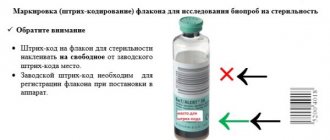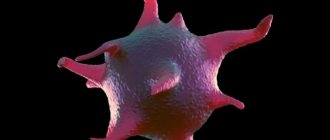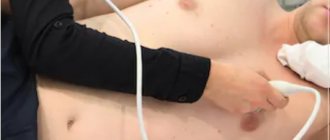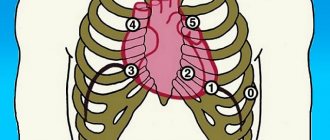Algorithm for taking blood from a peripheral vein with a syringe
To take blood at home you will need:
- Syringe of the required volume 2.0, 5.0, 10.0, 20.0;
- Alcohol wipes or cotton balls;
- Alcohol 96% or 70%;
- Venous tourniquet
- Latex gloves
General rules for taking blood from a vein:
- The tourniquet is applied for a short period of time (usually no more than 1 minute). A longer application of a venous tourniquet can lead to negative consequences: blood stagnation, increased thrombus formation, leading to difficulties in collecting blood.
- The place for puncture is usually chosen to be the veins of the elbow, forearm, and less often - the veins of the hand and foot;
- When using a rubber tourniquet, it is necessary to place a calico napkin under it (to avoid bruises and bruises from squeezing with the tourniquet);
- Before the manipulation, you need to tell the person about the procedure you will do.
Venous blood collection
See Necessary equipment for collecting venous blood
Preparing the patient for the blood donation procedure
- Preparation may vary depending on the analysis. For each specific analysis, if necessary, information can be obtained from the laboratory.
- Blood sampling occurs in the morning before 12.00, preferably between 8.00-10.00.
- Before the blood collection procedure, the patient must remain awake for at least 1 hour.
- On the day before the test, the patient can drink and eat as usual, but should only limit the consumption of alcohol, coffee and fatty foods.
- At least 10-14 hours should pass between the last meal and fluid intake and the blood draw. If necessary, you can drink no more than one glass of water without any additives.
- Before drawing blood you should avoid: Excessive physical and emotional stress
- Taking medications (if possible)
- Alcohol consumption
- Smoking
It is important to know
- The vacuum tube should be filled strictly to the specified volume to ensure the correct ratio of blood and additive - the blood in the tube should not be less than the specified volume (dilution effect) or more (danger of clotting).
- When drawing blood, you should hold the tube in such a position that the blood flows along the wall of the tube. If blood splashes onto the bottom of the tube and forms foam, it may promote hemolysis.
- Test tubes containing an anticoagulant must be turned upside down immediately after filling so that the blood mixes with the anticoagulant - at least 4 times when taking blood clotting tests, in all other cases 8 times. The air bubble should move from one end of the tube to the other. The test tube must not be shaken or shaken!
- If blood does not flow into the tube or the flow stops before the tube is filled, the cause may be a failed venipuncture or the vessel wall being sucked into the needle hole.
- Solution: change the position of the needle - insert the needle a little deeper, pull it back, change the angle at which the venipuncture was performed. If venipuncture is unsuccessful, another blood vessel should be punctured. Repeated puncture of the same vessel should be avoided.
- If there is enough blood in the yellow cap tube (serum tube) for testing, but the vacuum tube is not filled to the required volume, hemolysis may occur due to the remaining vacuum in the tube. To avoid this, quickly remove the stopper from the test tube to allow air to enter the test tube and close with a new stopper. The remaining tubes cannot be used if they are insufficiently filled.
- When drawing blood, do not rub or pat the intended puncture site. Excessively strong hand pumping can cause hemolysis and hemoconcentration.
- After disinfecting the skin, it should be allowed to dry so that particles of the disinfectant, which promote hemolysis, do not enter the test tube through the needle.
- Apply a tourniquet approximately 10-12 cm up from the puncture site. The tension of the tourniquet should be such that a finger can be placed between the tourniquet and the skin.
- Immediately loosen the tourniquet, making sure that blood flows into the tube.
- When drawing blood, it is important that the time the tourniquet compresses the blood vessels is minimal. Keeping the tourniquet in place for up to 1 minute does not particularly affect routine studies performed on blood serum.
- As a rule, blood is drawn in the elbow from the central vessel. For the patient, the elbow is less painful to pierce with a needle because the blood vessel is close to the skin. Alternative sites for venipuncture may include the inner forearm, wrist, and dorsum of the hand.
- Venipuncture/blood sampling is not performed: from an extensive scar surface, from a wound surface (burn wound), from an edematous surface, from a surface with a hematoma, from a cannulated vein, from a limb (arm) with a fistula for dialysis.
Venous blood collection procedure
1. Identify the patient. 2. Complete/check directions. 3. Find out whether the patient followed the prescribed diet and whether he is allergic to substances contained in the disinfectant for cleansing the skin at the venipuncture site. 4. Provide the patient with a comfortable and suitable position for drawing blood - the patient’s arm should be extended so that the arm forms a straight line from the shoulder to the wrist. 5. Wear gloves. 6. Prepare the necessary test tubes - shake them lightly to remove possible droplets of additives from the stopper. The test tubes will be installed in the required order. 7. Select a puncture needle of the required diameter and make sure that the needle is stable at the attachment point. Make sure that the protective cap does not interfere with vein puncture. 8. Select the puncture site. Ask the patient to clench his hand into a fist so that the veins are better visible. 9. Clean the site of the intended puncture with a disinfectant and allow the skin to dry. 10. If necessary, apply a tourniquet to your arm. 11. Remove the protective cap from the needle. Check whether the needle hole is free. 12. Perform a vein puncture - to do this, fix the vein with your finger slightly lower from the puncture site and slightly stretch the skin so that the vein does not move; Use a needle to pierce the vein wall at an angle of 15-30 degrees, the hole of the needle should be directed upward. 13. When drawing blood, make sure that the stopper of the tube is located higher and the bottom lower, to avoid substances from the test tube getting into the needle. 14. Holding the needle attachment point firmly with one hand, place the vacuum tube as close as possible to the needle attachment point so that the tip of the needle, covered with a latex cap, passes through the tube stopper. 15. The test tube should be held so that the blood flows down the wall of the test tube. 16. Immediately loosen the tourniquet, making sure that blood flows into the test tube. 17. When the test tube is filled with the required amount of blood and blood stops flowing into the test tube, remove the test tube from the mount and, if necessary, place the next test tube there. 18. Immediately after filling, the test tube with additives should be turned upside down and back again 4-5 times with calm movements so that the blood is mixed with the additives. 19. Place a dry cloth at the puncture site and remove the needle from the vein. 20. After use, immediately close the needle with a protective cap. To do this, you need to push the protective cap onto the needle with your finger. 21. Press the puncture site with a napkin for 3-5 minutes, the patient’s arm should be straightened. If necessary, apply a bandage to the puncture site. 22. Label the test tubes. 23. With calm movements, turn the test tube upside down and back again 4-5 times. Place the test tubes on a stand in a vertical position. 24. Dispose of the used needle and needle holder in an appropriate waste container.
Vacuum tube
This is a worthy alternative to the usual glass tubes and disposable syringes. Vacuum tubes immediately attract attention with multi-colored markings - each analysis has its own color, the reagent necessary for a specific study is already inside.
They are easy to use: the test tube contains a vacuum, which ensures that the volume of blood strictly necessary for a specific study is taken.
Article on the topic
How to understand blood tests Test tubes are made of plastic or laboratory glass, they are unbreakable and easy to recycle.
Menu
Algorithm for completing the donation procedure
First of all, make sure that you have no medical contraindications to blood donation. If you have doubts about your health, be sure to tell your doctor about them during the medical examination; by hiding information about your health, you are putting your health, as well as the health and lives of other people, at risk!
• Find out the work schedule of the Republican Blood Transfusion Station (see Contacts)
• You must take your passport and SNILS with you to the blood transfusion station.
• At the blood center, contact the reception desk. You will be registered and asked to fill out a form.
• Each time a donor visits a blood transfusion station, a medical examination is performed. Based on the results of the examination, the transfusiologist will decide whether to allow you to donate blood. If temporary contraindications to donation are detected, the doctor will explain when you can come another time. If there are constant contraindications, you will not be able to be a donor, but even in this case, you have the opportunity to participate in the donor movement as a volunteer - offer to become donors to your family and friends, take part in campaign events, organize a donor day at your company.
• After examination, the donor is sent to a laboratory where the blood type and hemoglobin level are determined.
• Before donating blood, the donor will be invited to visit the buffet to drink sweet tea. This will help improve blood flow, which will have a beneficial effect on your condition during and after donation.
• Blood donation takes place in a reclining position. The entire procedure takes from 10 to 20 minutes (plasma donation from 40 to 60 minutes). When collecting blood, only sterile disposable plastic containers are used, which are closed systems to prevent infection of the donor. A single dose is 450 ml of blood or 600 ml of plasma + blood in an amount of up to 40 ml is taken into a test tube for analysis.
• Upon completion of the donation, you will be given a sterile dressing, which should not be removed for 4 hours.
• It is recommended to rest a little, drink tea and avoid physical activity for the rest of the day.
• Go to the cash desk to receive a payment for food, the amount of which is established in accordance with: Federal Law-125 of June 20, 2012 “On the donation of blood and its components.”
• Download the “Blood Service” mobile application and receive an individual donation code at the reception or in room 118 to view your test results.
Periodic blood donations have a beneficial stimulating effect on the donor's body. For a healthy person, such blood donation is safe and does not cause changes in health. The body has great compensatory capabilities and quickly restores the complex of cellular elements lost during blood donation. At the same time, donors maintain good health, mood and ability to work. Donation is honorable and will undoubtedly bring moral satisfaction and self-confidence. Take care of yourself – every day and especially on the day of donating blood. Today you have already done an incredibly important thing! Thank you for being with us!
No needle visible - no fear
Not long ago, disposable lancets of a new modification appeared: a thin needle is invisible before and after the puncture. She hides comfortably in the capsule, and a person, without seeing her, does not experience psychological discomfort. Pain during blood sampling from a finger is minimal, the wound surface is small, and it heals much faster than when using standard needles.
The sterile needle in the lancet is automatically returned to the capsule immediately after use. It is impossible to inject yourself accidentally, which means you cannot become infected with blood-borne infections. It is also impossible to use again - a hidden lock prevents the needle from coming out again. This solves another issue – safe disposal. Similar lancet needles are also used to take blood from a baby’s heel.








